Introduction
Front
{{section_header}}{{section.name}}{{/section_header}}

Back
{{section_header}}{{section.name}}{{/section_header}}

Left
{{section_header}}{{section.name}}{{/section_header}}
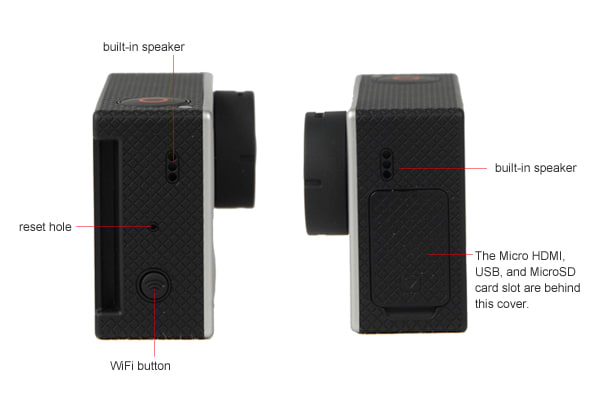
Right
{{section_header}}{{section.name}}{{/section_header}}
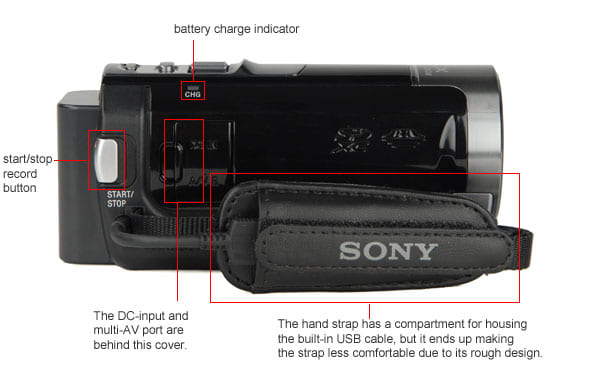
Top
{{section_header}}{{section.name}}{{/section_header}}

Bottom
{{section_header}}{{section.name}}{{/section_header}}

In the Box
{{section_header}}{{section.name}}{{/section_header}}

The Panasonic TM90 comes packaged with a number of accessories, including:
- AV multi cable (Component and composite)
- USB cable
- AC adapter
- AC cable
- VW-VBK180 battery pack
- Touchscreen stylus
- Cold shoe adapter
- Manuals/Software
Color
{{section_header}}{{section.name}}{{/section_header}}
We found the TM90 excelled in reproducing accurate colors in video testing, with an average color error of just 3.52. The camera's videos also had an accurate saturation level, at an excellent 97.04% of the ideal. It's tough to find fault here, as these are all big improvements over last year's mid-range camcorders from Panasonic. More on how we test color.
Color Accuracy Performance
Color Error Map The map above is a diagram of the color error. The length and direction of each line indicates how the camera processed each particular color while capturing video.
The Panasonic HDC-TM90 produced a color error of 3.52 and a saturation level of 97.04% in our bright light color testing.
Like other models from Panasonic, there are not any color modes, in the traditional sense, on the TM90. Instead, users are offered the option to make small adjustments to color, sharpness, exposure, and white balance (this is different from the white balance settings that are also included). Making adjustments to the color option primarily impacts saturation, with users able to create videos with either very muted or vibrant colors.

The TM90 produced videos that were much more accurate than the other mid-range camcorders that we compared it to. It tested with more accurate colors and a much more accurate saturation level than the Sony CX150, Canon M31, or last year's Panasonic HS60. Both the Canon and Sony models showed color errors that were on average between 4.5 and 5, while the HS60 had a color error of 3.89. The biggest improvement for the TM90 in its ability to recreate an accurate saturation level in both bright and low light.
Below are some examples of the colors that we pulled from test videos from each of the cameras in our comparison group. On the left is the ideal, and it's easy to see how close the TM90 is compared to the other models in this group.
Owing to its improved color accuracy and much-improved saturation levels, the TM90 easily outpoints each of its fellow mid-range camcorders. Panasonic already was performing well in this category with the HS60, the TM90 simply improves upon that lead in these direct comparisons.
{{comparison_bars title="Color Score Comparison", attribute="Color Score", xLabel="Color Score"}}
Low Light Color
{{section_header}}{{section.name}}{{/section_header}}
The Panasonic TM90 had a low light color error of just 5.34 in our testing with the 1080/60i mode, with a saturation level of 84.49% of the ideal. Both of these scores were an improvement over last year, and coupled with the increased sensitivity make the TM90 a great option for shooting in low light. More on how we test low light color.
Low Light Color Accuracy Performance
Color Error Map The map above is a diagram of the color error. The length and direction of each line indicates how the camera processed each particular color while capturing video.
The Panasonic HDC-TM90 produced a color error of 3.52 and a saturation level of 97.04% in our bright light color testing.
While all of our comparison cameras produced a color error of around 5.5 in our low light testing, the TM90 was still the best of the lot. The TM90 really put distance between itself and its competitors with its saturation scores, however, as all the cameras we pitted it against had a nasty habit of producing muted, undersaturated images in low light.
Noise
{{section_header}}{{section.name}}{{/section_header}}
Panasonic has apparently completely re-tooled how the TM90 processes noise over previous models, with the company claiming a 45% reduction over similar models from last year's line in dim lighting. We tested the HDC-HS60—one of the models cited by Panasonic—and found that it produced 0.6275% noise in bright light conditions and 1.5725% in low light. The TM90, by comparison, performed worse in bright light, with an average of 0.838% noise, owing to a significant drop in signal fidelity in the blue channel. In low light, the TM90 did improve as advertised, but bright light noise is one of the few areas the TM90 fell behind last year's Panasonic range. More on how we test noise.

There's not much visible noise in any of the crops above, but you can definitely see the sharpening being applied by both Panasonic cameras and the chromatic aberration in the Sony CX150. The Canon M31 has the sharpest shot here, but these are all taken at 1080/60i. The Panasonic TM90 is much sharper than you see here when shooting with its 1080/60p mode.
{{comparison_bars title="Noise Score Comparison", attribute="Noise Score", xLabel="Noise Score"}}
Low Light Sensitivity
{{section_header}}{{section.name}}{{/section_header}}
The Panasonic TM90 needed just 12 lux of light to record an image while zoomed in, with just 9 lux required when shooting at the widest angle. The disparity is due to the nature of the camera's maximum aperture, which is larger (f/1.8) when zoomed out than zoomed in (f/3.5). This result is slightly better than the HS60 model from Panasonic that we tested last year, despite the fact that the TM90 actually has a slightly smaller aperture at the telephoto end. More on how we test low light sensitivity.
The TM90 required the least amount of light to produce an image that crossed 50 IRE on a waveform monitor of any of our comparison cameras. It showed just a small improvement over the Panasonic HS60, but needed only half the light of the Sony CX150 and Canon M31 models.
{{comparison_bars title="Low Light Sensitivity Comparison", attribute="Low Light Sensitivity Score", xLabel="Low Light Sensitivity Score"}}
Low Light Noise
{{section_header}}{{section.name}}{{/section_header}}
The Panasonic TM90 is a solid performer in low light, but it does come at a bit of a cost, as it does have some noise apparent in its images. In low light testing, we found videos had a total noise of 1.19%. Anything over 1% generally starts to become visible, so it was nice to see that, while not perfect, this was still a big improvement over last year's HS60. More on how we test low light noise.

The TM90 fell short in only one category in low light: total noise percentage. The only camera that beat it was the Sony CX150, though that appears to be due to heavier noise reduction being applied, resulting in less fine detail. The Sony only had to deal with 0.94% of noise, which gave it the top score in this comparison category. The Canon M31 was worse, with 1.4% noise, but the HS60 was the worst here, with more than 1.5% noise. According to Panasonic, the TM90 can more effectively weed out more low frequency noise than the HS60, and that showed in our testing.
{{comparison_bars title="Low Light Noise Score Comparison", attribute="Low Light Noise Score", xLabel="Low Light Noise Score"}}
Low Light Color
{{section_header}}{{section.name}}{{/section_header}}
The Panasonic TM90 had a low light color error of just 5.34 in our testing with the 1080/60i mode, with a saturation level of 84.49% of the ideal. Both of these scores were an improvement over last year, and coupled with the increased sensitivity make the TM90 a great option for shooting in low light. More on how we test low light color.
Low Light Color Accuracy Performance
Color Error Map The map above is a diagram of the color error. The length and direction of each line indicates how the camera processed each particular color while capturing video.
The Panasonic HDC-TM90 produced a color error of and a saturation level of in our bright light color testing.
While all of our comparison cameras produced a color error of around 5.5 in our low light testing, the TM90 was still the best of the lot. The TM90 really put distance between itself and its competitors with its saturation scores, however, as all the cameras we pitted it against had a nasty habit of producing muted, undersaturated images in low light.
Motion
{{section_header}}{{section.name}}{{/section_header}}
The Panasonic TM90's motion results were quite good, with little in the way of trailing and ghosting affecting the resultant video. This follows in the footsteps of last year's Panasonic SD600, which also featured the 1080/60p mode in a camera for under $1000. In our testing we found that there was almost no difference in the motion results of the TM900/TM700 and the TM90 using this mode. More on how we test motion.

Video Sharpness
{{section_header}}{{section.name}}{{/section_header}}
The Panasonic TM90 offers no shortage of frame rate and resolution options to users, with the ability to record in Panasonic's 1080/60p, AVCHD 1080/60i, and iFrame 960x540p formats. Unsurprisingly, we found that the 1080/60p format produced the sharpest results, with the TM90 able to resolve 800 lw/ph horizontally and vertically. Those are very strong results, and offer an improvement vertically over last year's already-competent HS60 from Panasonic. Among our comparison cameras, the TM90 had the best combined sharpness scores. More on how we test video sharpness.
{{comparison_bars title="Video Sharpness Score Comparison", attribute="Video Sharpness Score", xLabel="Video Sharpness Score"}}
Ease of Use
{{section_header}}{{section.name}}{{/section_header}}
The Panasonic TM90 features a 3-inch touchscreen LCD on this year's model, up from a 2.7-inch screen last year. That extra screen space comes at a cost: there's no more physical buttons beneath the screen, as everything's touch controlled now. Most major adjustments can be made without going into the full menu, though the symbols for these functions are not accompanied with text, so you will have to learn what each means through trial-and-error.
Once in the full menu, however, there is an information button that, when activated, will offer insight into whatever control or menu function you press next. The only issue is that once this info button is used, it reverts back to off. This is especially frustrating when trying to make sense of multiple, ambiguous choices on one page, such as in the scene mode menu.
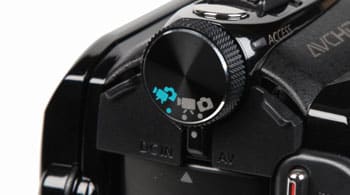
Auto Mode is confusingly called Dual Shot mode
The TM90 alternates between still shooting, playback, and video recording by the use of a mode switch on the right side of the camera. It's placed just out of the way so as to not be accidentally engaged, but that also means that it's not in a place where the thumb or index finger falls naturally.

Auto Mode
{{section_header}}{{section.name}}{{/section_header}}
The intelligent automatic mode on the Panasonic TM90 handles most of the heavy lifting for users just looking to get solid full HD shots. There aren't really any manual controls or overrides available in this mode, as automatic handles all the exposure and picture adjustments.
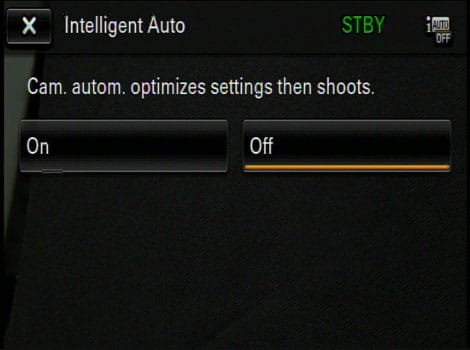
The iAuto mode button is difficult to find, but when you do find it the option for turning on the mode looks like this.
Auto Controls
{{section_header}}{{section.name}}{{/section_header}}
The Panasonic TM90 has a fairly responsive automatic operation. Quick changes in lighting, such as walking from inside to outdoors on a bright day, require only a few seconds for the camera to properly adjust. Autofocus is also quite fast, though the lens does not have a very close focusing distance unless the macro setting is engaged. There is not much focus hunting in low light, and an LED lamp on the front of the camera can assist here when necessary.
Handling
{{section_header}}{{section.name}}{{/section_header}}
The TM90 has a fairly typical, flimsy Velcro-and-leather hand strap. It's not incredibly comfortable for a $500+ camera, but it gets the job done. The body is mostly smooth plastic, though the right side of the camera has a grooved pattern that offers more stability. Panasonic has not only decided to keep the abysmal power button from last year's HS60, but tucked it into the least accessible corner of the panel, right next to the LCD. The TM90 then uses that same awful button design for the auto/manual, image stabilization, and 1080/60p switches, so your frustration at a button requiring three attempts to press isn't limited simply to turning the camera on and off any more. Maybe next year Panasonic can just go all out and use a "ballpoint pen" reset button for every function on the camera.

The TM90 features a standard cold shoe adapter that slots into the rear of the camera, just above the battery. It definitely sticks out a little awkwardly from the camera, but it provides the ability to add much more effective audio recording and lighting options. Panasonic offers only a few solutions that make use of this, but really any accessory that mounts to a shoe that has its own power source will work fine.

Generally, operating the controls on the TM90 is a two-handed affair. Other than starting and stopping recording and using the camera's optical zoom, there's not much you can control without using the touchscreen or the buttons on the side of the camera. There's little in the way of innovative design here, but if this form factor is what you're looking for, the TM90 handles about as well as you can expect.


These dedicated buttons give you quick access to aperture and shutter speed controls.
Portability
{{section_header}}{{section.name}}{{/section_header}}
The Panasonic TM90 packs a lot of features into a very light package, with 16GB built-in flash storage, a 21x optical zoom lens, and the ability to record 1080/60p video in a camera that weighs just 288 grams. If you ever had to shoulder a large DV camera for an extended period of time, you'll appreciate just how much these cameras have shrunk in size and weight. With an included battery that sits nearly flush with the rear of the camera and a media slot on the bottom, there are no noticeable protrusions from the TM90—with the only exception being the accessory cold shoe adapter that is included. Otherwise the TM90 fits easily into a jacket pocket or in a small bag and won't require a great deal of extra space in any pack or suitcase.
Battery Life
{{section_header}}{{section.name}}{{/section_header}}
Panasonic lists the battery life of the VW-VBK180 that comes with the TM90 as approximately 1 hour and 35 minutes when recording in the 1080/60i mode, with the highest quality settings turned on. We found that, while just continuously shooting video, it outlasted that mark by about 12 minutes. While powering the camera on and off and using the optical zoom would impact the battery life somewhat, 107 minutes is about what we expect from a camera/battery combo of this size. More on how we test battery life.
The included VW-VBK180 battery pack sits in the battery compartment on the rear of the camera, protruding just slightly beyond the back of the camera's body. There is also an optional VW-VBK360 battery that provides double the charge, with Panasonic rating it with a life of three hours, 15 minutes. The batteries can be charged externally if you purchase an optional accessory kit, but otherwise charge right in the camera using the included AC adapter.

{{comparison_bars title="Battery Life Comparison", attribute="Battery Life Score", xLabel="minutes"}}
LCD
{{section_header}}{{section.name}}{{/section_header}}
With no viewfinder, the Panasonic TM90 relies entirely on its 3-inch touchscreen LCD for framing, control, and menu navigation. It's a bright LCD that sits flush with the body of the camera when closed, but isn't incredibly high resolution with just a 230k-dot display. It's generally quite responsive to touch control and just large enough that the lack of either a viewfinder and physical menu and navigation buttons is not a huge concern. Panasonic includes a plastic stylus with the TM90, though we never found it necessary. Like most LCDs of this type the screen isn't totally visible in bright light, but it has full rotational capability so finding a workable angle isn't difficult.
Stabilization
{{section_header}}{{section.name}}{{/section_header}}
In our testing, we found the stabilization feature to be greatly improved on the Panasonic TM90. With optical image stabilization activated, the resulting footage saw a comparative improvement of 73% in high shake scenarios and 76% when tested with less shake applied to the camera. These are certainly good results, and were nearly twice as good as last year's HS60, right in line with Panasonic's claims about the camera. More on how we test stabilization.
The Panasonic TM90 offers both an optical image stabilization and a hybrid stabilization mode that adds in "electric" stabilization to correct for hand shake. We found only a marginal improvement with hybrid stabilization activated over just powered optical image stabilization, though this was only really evident where shake was the most severe.
We found the stabilization on the Panasonic TM90 to be the best in our comparison group. With a comparative improvement of over 70%, it tested far better than the Sony CX150, Panasonic HS60, and Canon M31 managed. There was certainly an element of over-correction vertically—and you'll want to keep stabilization off when panning with a tripod—but not anywhere to the extent of the other cameras.
Manual Focus
{{section_header}}{{section.name}}{{/section_header}}
The TM90 is a consumer-level camcorder with a simple design that is easy to pick up and shoot with, but still provides some measure of manual control where desired.
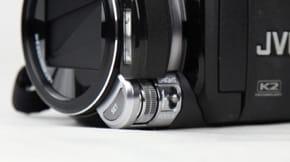
The adjustment dial makes accurate focus adjustments easy.
Miscellaneous Controls
{{section_header}}{{section.name}}{{/section_header}}
Face Recognition
The face recognition feature on the TM90 works about as well as you can expect, though its ability to store and display names right on the LCD is a nice extra touch. It's not a must-buy feature, but it's good if you're prone to forgetting the names of your own children.
Guide Lines
The TM90 offers the ability to overlay guide lines in one of three patterns to help with framing and composition. They're fairly typical, offering three horizon lines, a rule of thirds option, and a grid that covers the entire frame.
Auto Slow Shutter
The TM90 has two auto slow shutter controls, one for 2D and one for 3D. They work basically by maintaining a lower shutter speed than the camera otherwise might to try and preserve detail in shadowed areas. Panasonic makes it fairly clear that you should always leave the 3D option on, as the conversion lens cuts out a significant amount of light when in use.
Tele Macro
The TM90 features Panasonic's familiar tele macro mode, which will zoom in and focus on subjects that are 50cm or further away.
Backlight Compensation
The TM90 can detect backlit subjects and attempt to adjust its exposure settings and gain to preserve detail and brighten up the subject.
Auto Controls
{{section_header}}{{section.name}}{{/section_header}}
The Panasonic TM90 has a fairly responsive automatic operation. Quick changes in lighting, such as walking from inside to outdoors on a bright day, require only a few seconds for the camera to properly adjust. Autofocus is also quite fast, though the lens does not have a very close focusing distance unless the macro setting is engaged. There is not much focus hunting in low light, and an LED lamp on the front of the camera can assist here when necessary.
Audio Controls
{{section_header}}{{section.name}}{{/section_header}}
While in manual mode, the audio level can be adjusted for the built-in microphone (or an external microphone, if you're using the 3.5mm jack on the inside of the camera). There is also a zoom mic feature with the Panasonic TM90 that will attempt to adjust its audio input to synchronize with the camera's zoom, so wide shots offer more ambient noise while telephoto shots take in more targeted audio.

Editing
{{section_header}}{{section.name}}{{/section_header}}
The TM90 comes bundled with HD Writer AE 3.0, which offers basic editing and archiving functionality along with the ability to export videos to social sharing sites like Facebook and Youtube. The software isn't the most robust suite ever, as it does not work on Mac platforms and has no multiple-monitor support. If you're shooting either 1080/60p or 3D video with the TM90, however, it does offer some measure of editing support for those files and it's designed to be as simple to use as possible. For an overview of the software that ships with this and other camcorders, see our article: Video Editing Software For Your Camcorder{{product.brand.name}}-Included-Software.htm.
There aren't a great deal of in-camera editing options available on the TM90. It has the typical ability to split up clips and then delete unwanted portions of video, though there's nothing in the way of color or sharpness adjustments or filters.
Compression
{{section_header}}{{section.name}}{{/section_header}}
The TM90, like several other Panasonic models, makes use of their 1080/60p recording mode, though the AVCHD standard does not support 1080/60p. Sony is also beginning to release cameras capable of shooting in 1080/60p, though, so it's becoming more accepted. The camera thus also has options for recording in AVCHD 1080/60i and iFrame 540/30p formats for easier editing. The 1080/60p video is one of the main reasons to buy this camera—it's noticeably superior to the 60i footage—but because this is a non-standard format there are some extra steps you're going to have to take in editing and archiving that footage to play it on a television, unless you want to just play it off of your camera. Read more about the advantages and disadvantages of various high definition compression types.
Media
{{section_header}}{{section.name}}{{/section_header}}
The TM90 features 16GB of built-in flash memory to which it can record. That's enough space to hold two hours, 20 minutes of 1080/60p video, or four hours, 10 minutes of 1080/60i at the highest quality setting. The camera also supports SD/SDHC/SDXC cards, with a slot on the bottom of the camera for these cards. It sits rather far from the tripod mount, but some tripod plate designs may prevent switching without taking the plate off. Panasonic recommends at least class 4 SD cards for 1080/60p recording, though we'd say play it safe with at least class 6 cards. Read more about the advantages and disadvantages of various media types.

Still Features
{{section_header}}{{section.name}}{{/section_header}}
The TM90 features the ability to record 5-megapixel still images, in addition to its HD video. Five megapixels is beginning to enter the range of useful for purposes other than social media networks and e-mail, as it can be printed to a reasonable size. While it's clearly not a still camera, the TM90 can do the job in a pinch.
Lens & Imaging System

LCD
{{section_header}}{{section.name}}{{/section_header}}
With no viewfinder, the Panasonic TM90 relies entirely on its 3-inch touchscreen LCD for framing, control, and menu navigation. It's a bright LCD that sits flush with the body of the camera when closed, but isn't incredibly high resolution with just a 230k-dot display. It's generally quite responsive to touch control and just large enough that the lack of either a viewfinder and physical menu and navigation buttons is not a huge concern. Panasonic includes a plastic stylus with the TM90, though we never found it necessary. Like most LCDs of this type the screen isn't totally visible in bright light, but it has full rotational capability so finding a workable angle isn't difficult.
Connectivity
{{section_header}}{{section.name}}{{/section_header}}
The Panasonic TM90 includes four ports on the inside control panel of the camera: mini-HDMI, multi A/V, USB, and a 3.5mm audio input terminal. The mini-HDMI is a standard port, while the USB port should work with the included cable and most mini-USB cables. The A/V multi cable included with the TM90 can be used to connect the camera via either component or composite connections, as well. On the right side of the camera, located behind a swiveling panel, is the input for using the AC adapter to charge the battery or operate the camera without draining battery power.
One of the nicer additions to the TM90, compared to most consumer cameras, is the cold shoe port located above the rear battery compartment. The cold shoe attachment accessory included with the camera can be slotted in here, allowing the easy attachment of external microphone and lighting setups. It provides no power, but it makes using many external mics and lights a breeze.
Battery
{{section_header}}{{section.name}}{{/section_header}}
The included VW-VBK180 battery pack sits in the battery compartment on the rear of the camera, protruding just slightly beyond the back of the camera's body. There is also an optional VW-VBK360 battery that provides double the charge, with Panasonic rating it with a life of three hours, 15 minutes. The batteries can be charged externally if you purchase an optional accessory kit, but otherwise charge right in the camera using the included AC adapter.

Media
{{section_header}}{{section.name}}{{/section_header}}
The TM90 features 16GB of built-in flash memory to which it can record. That's enough space to hold two hours, 20 minutes of 1080/60p video, or four hours, 10 minutes of 1080/60i at the highest quality setting. The camera also supports SD/SDHC/SDXC cards, with a slot on the bottom of the camera for these cards. It sits rather far from the tripod mount, but some tripod plate designs may prevent switching without taking the plate off. Panasonic recommends at least class 4 SD cards for 1080/60p recording, though we'd say play it safe with at least class 6 cards. Read more about the advantages and disadvantages of various media types.

3D Lens
{{section_header}}{{section.name}}{{/section_header}}
The 3D conversion lens that can be used with the TM90 is a fixed focal length, with a 35mm equivalent focal length of 58mm and an aperture of f/3.2. It weighs 193 grams, according to Panasonic, so it's going to unbalance the camera somewhat. Shooting 3D in this method will require more light than typical 2D shooting, so you'll want to make sure there's plenty of light available.
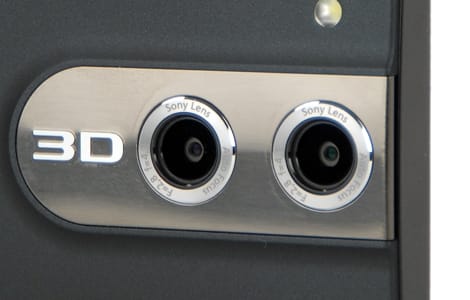
The second built-in lens is what lets you record video in 3D—without any tricky calibration.
When the TM90 detects that the 3D conversion lens has been attached, it will automatically provide on-screen instructions for adjusting the lens' position and calibrating it for the best performance.
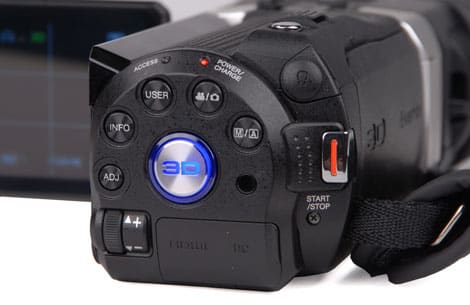
You can adjust a variety of controls—including zoom and focus—in 3D record mode.
3D Controls
{{section_header}}{{section.name}}{{/section_header}}
Recording 3D video with the TM90 does take away a good measure of the camera's feature set: still picture recording, zoom functionality, intelligent auto mode, manual adjustments to the picture and shutter/iris control, hybrid optical image stabilization (normal optical IS is still functional), autofocus/exposure tracking, guide lines, scene modes, the zoom microphone, and tele macro are all unavailable when shooting 3D. The 3D videos are also not high definition, as the camera is recording two images side-by-side with a single sensor.
3D Playback
{{section_header}}{{section.name}}{{/section_header}}
The resultant 3D video can be viewed on the LCD, but only in 2D. In order to view the images in 3D they must be played on a compatible 3D television. The camera can switch between 3D and 2D playback automatically, and 3D videos can be played in single-screen 2D through the menu. If you play a 3D video back on a non-3D compatible television without adjusting this setting, the images will be displayed side-by-side. All videos shot in 3D are played back with a gray frame.
Still Features
{{section_header}}{{section.name}}{{/section_header}}
The TM90 features the ability to record 5-megapixel still images, in addition to its HD video. Five megapixels is beginning to enter the range of useful for purposes other than social media networks and e-mail, as it can be printed to a reasonable size. While it's clearly not a still camera, the TM90 can do the job in a pinch.
Other Features
{{section_header}}{{section.name}}{{/section_header}}
Relay Recording
The Panasonic TM90 makes use of both SD/SDHC/SDXC memory cards and its own 16GB of internal flash memory. Relay recording, when activated, allows users to shoot their video on the internal memory and, when that is full, immediately begin recording to the memory card. This feature then allows transferring the entire recorded video to the card, assuming that there is enough space to accommodate the file. This is especially useful when recording in 1080/60p, as its high bitrate will fill up the internal memory quickly.
Auto Ground-Directional Standby
Auto Ground-Directional Standby simply pauses the camera's recording if it detects that it is upside-down or if it its pointed at something directly above or below you. It's meant to try and preserve data in case of a drop or to prevent wasted recording if you lower the camera from a shooting position and forget to hit stop.
Fader
The TM90 allows users to automatically end a solid black or white fade to the beginning and end of all clips. There's little control over the feature other than deciding between a black or white effect.
Pre-Record
Pre-Record can be turned on in the menu and will keep approximately a three second buffer constantly so that all recordings begin before the user actually presses the button. It's a great feature if you're trying to save space and recording something where unexpected action might take place, such as a whale watch.
Panasonic HDC-HS60 Comparison
The Panasonic TM90 and Canon M31 both have a lot of things going for them. If you were to simply compare the two on paper, the M31 would certainly win points for having greater sensor resolution and double the internal memory. The TM90 would weigh down the scales with a wider angle lens, larger zoom range, 1080/60p recording, and a smaller form factor.
Once you get the two cameras in the lab and compare the footage, though, it's clear the TM90 outperforms the Canon M31 in nearly every category. The Canon suffered from inaccurate colors and low saturation, higher image noise, and overall lower sharpness. The M31 did offer superior results when recording primarily motion or in 1080/60i, but it was really let down by poor performance in low light compared to the TM90.
The Canon M31, while older, also has the burden of a much higher estimated retail price of $699, while the TM90 is $150-200 cheaper.
The M31 does have some advantages in handling, with buttons that are not nearly as poor as the barely-there and difficult to control ones used on the TM90. The Canon also has a hot shoe, but it's the company's proprietary mini-advanced shoe, so there's a dearth of products that actually take advantage of it. It's telling that the most commonly found accessory is an adapter that just turns it into the same universal cold shoe that the TM90 already ships with.
There's clearly a reason Canon returned to the drawing board with the M41 this year, and between these two cameras it's really no contest. The Canon M31 isn't a bad camera, and the extra 16GB internal storage is a nice extra for Canon owners, but the TM90 is simply the better, cheaper option.
Sony Handycam HDR-CX150 Comparison
The Panasonic TM90 and SD90 are successors to the HS60's family of 2010 mid-range camcorders. Panasonic seems to have worked directly off that line when developing the TM90, tweaking performance and making a few design changes that have improved the shooting quality of the line.
We found that the TM90 outperformed the HS60 nearly across the board. The TM90 was more sensitive in low light, had better color accuracy and saturation in every lighting condition, shot more pleasing motion with sharper details, with a wider angle of view and a slightly greater zoom range.
Our major qualms with the TM90 came with its design changes. A bump in LCD size from 2.7 to 3 inches has necessitated exchanging the membrane buttons at the bottom of the screen for full touch control. Furthermore, the media slot has been relocated to the bottom of the camera from the inside panel. In its place are several frustratingly embedded buttons for automatic/manual mode, 1080/60p recording, and optical image stabilization.
It's that design change that is most frustrating about the TM90, as those buttons that were previously actual buttons are now embedded on the body of the camera. It's an inelegant control scheme, to say the least. What made Panasonic believe such a change was warranted or desired, we don't know.
In the end, it's a regression in design, though these are only small issues that are easily overlooked given the TM90's otherwise solid performance.
COMP 3
The TM90 and Sony CX150 sit right at the top of their respective mid-range lines for Panasonic and Sony, both featuring 16GB built-in memory, SDHC/SDXC compatibility, full HD video recording (though 60i vs 60p), 1/4'' CMOS sensors, and roughly equivalent zoom ranges.
On paper, these are two very similar camcorders, though in practice the Panasonic TM90 outperforms the admittedly older CX150 in most categories. The TM90 showed more accurate color rendition, with near-perfect saturation levels, sharper images, improved image stabilization, and solid motion performance, with little artifacting or interference.
The TM90 also offers 1080/60p recording, as opposed to the CX150, which outputs 1080/60p from the camera, but records in 1080/60i AVCHD. Most of our testing was done utilizing the TM90's 1080/60i AVCHD mode, which is more widely supported, so these scores are actually quite comparable. We do make use of the 1080/60p mode in sharpness and motion testing, and here the Panasonic TM90 distanced itself quite a bit from the CX150.
The greatest advantage for the Sony CX150 came in noise testing, where Sony's combination of a back-illuminated sensor and apparently heavier noise reduction worked to keep noise to less than 1%, even in dim lighting. The Panasonic TM90 showed improvement over previous models, but had more visible noise than the Sony CX150.
In hand, these are two very similar cameras and blindfolded you'd be hard-pressed to tell the two apart. When it comes down to simple image performance, though, the Panasonic TM90 outperforms the Sony with good scores at their shared 1080/60i AVCHD mode, and even sharper results with 1080/60p recording.
Conclusion
While Panasonic's mid-range consumer camcorder lineup is perhaps a little too congested with seven high-definition models under $600, the TM90 and SD90 are the top of that group, with the most impressive specs of the lot.
The TM90 combines a compact body design and 28mm wide-angle lens with a 21x optical zoom, 1080/60p recording, optional 3D capability, 1/4.1'' CMOS sensor, and 3-inch touchscreen LCD. Altogether, it's an impressive package that is fairly affordable when you consider its performance in our testing. We found the TM90 to be very capable, recording crisp motion with above average sharpness and accurate color rendition. Saturation was nearly perfect, placing the TM90 among the better scoring mid-range consumer camcorders we have looked at this year.
The TM90 (and SD90, by extension) brings down many of the features of the much more expensive Panasonic models, chief among them the 28 Mbps 1080/60p recording mode that debuted in the TM700 last year. The videos in 1080/60p looked crisper, with better motion reproduction and sharper images than those shot in 17 Mbps 1080/60i. One headache: the 1080/60p is not officially a part of the AVCHD format, so your options for editing and archiving are going to be limited, but it's a feature that most consumer cameras simply don't offer at any price.
The camera is not without its quirks, however. Compared to last year's models, the TM90 has quadrupled the camera's use of the small embedded buttons that sit flush with the body and offer no tactile feedback. These indented devils are so frustrating to use, we half expected to see an apology listed under the layout diagrams in the manual. Luckily, they don't control features that have to be used all that often.
If anything, that frustration only brings into relief how impressively the TM90 performs on the whole. The camera scored well in the majority of our tests, with Panasonic offering big improvements to image stabilization and low light noise processing over last year's models.
Photo Gallery
{{photo_gallery "Front Photo", "Left Photo", "Left Open Photo", "Back Photo", "Right Photo", "Top Photo", "Bottom Photo", "Lens Photo", "Lens Photo 2", "3D Lens Photo", "Media Photo", "Easy Mode Photo", "Manual Controls Photo", "Zoom Photo", "Zoom Photo 2", "Ease of Use Photo", "Battery Photo", "LCD Photo 1", "LCD Photo 2", "EVF Photo 1", "EVF Photo 2", "Mic Photo", "Mic Photo 2", "Ports Photo 1", "Ports Photo 2", "Ports Photo 3", "Ports Photo 4", "Ports Photo 5", "Ports Photo 6", "Handling Photo 1", "Handling Photo 2", "Handling Photo 3", "Handling Photo 4", "Box Photo"}}
Meet the tester
TJ is the former Director of Content Development at Reviewed. He is a Massachusetts native and has covered electronics, cameras, TVs, smartphones, parenting, and more for Reviewed. He is from the self-styled "Cranberry Capitol of the World," which is, in fact, a real thing.
Checking our work.
Our team is here for one purpose: to help you buy the best stuff and love what you own. Our writers, editors, and lab technicians obsess over the products we cover to make sure you're confident and satisfied. Have a different opinion about something we recommend? Email us and we'll compare notes.
Shoot us an email


